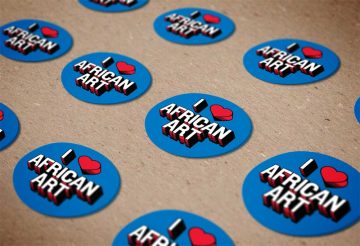
Home | That Liberty and Equality Might Yet Reign | Legends—Looking Back, Facing Forward | Divine Endurance: Ethiopia | Our Ancestors Lived Free | We Are…: Women Warriors | A Long Walk to Freedom: South Africa | Independent Africa Faces Forward
—Emperor Menelik II, renouncing Italy’s claims to Ethiopia, 1893
Ethiopia—Divine Endurance
“Ethiopia has need of no one, she stretches her hand unto God.”—Emperor Menelik II, renouncing Italy’s claims to Ethiopia, 1893
Solomon Belachew
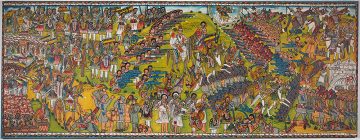
1919-2002, b. Gojjam area, Amhara Region, Ethiopia
Worked in Addis Ababa, Ethiopia
Battle of Adwa
1970
Oil on canvas
Gift of Miriam and Michael Dow, 2003-19-1
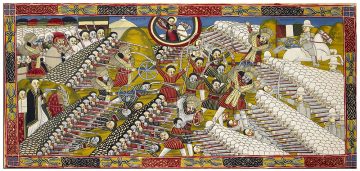
Ethiopia
Battle of Adwa
1968
Oil on canvas
Gift of Joseph and Patricia Brumit, 2004-7-60
Hero in History: Emperor Menelik II
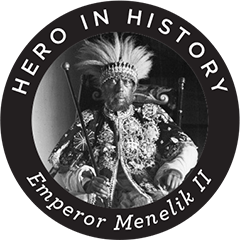
- Crowned ruler of the constituent kingdom of Shewa, Menelik claimed descent from the union of King Solomon and the Queen of Sheba. Outmaneuvering rivals, he received the imperial crown on Nov. 3, 1889.
- Menelik decisively rejected an Italian attempt to establish a protectorate over Ethiopia in 1893, and repelled their military invasion at Adwa in 1896.
- Menelik expanded and consolidated the borders of the Ethiopian state, suppressed the slave trade, established new ministries, built a new imperial capital—Addis Ababa—and introduced a series of new technologies, including the railway, electricity, telephones, automobiles, and indoor plumbing.
“Ethiopia has need of no one, she stretches her hand unto god."
—Emperor Menelik II, renouncing Italian claims to the country, in 1893Ethiopian artist
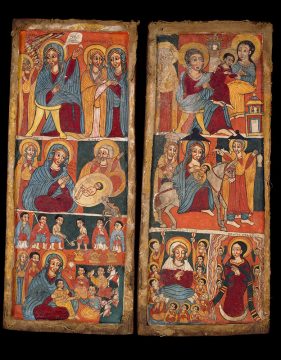
Vicinity of Gondar, Amhara Region, Ethiopia
Icon in the form of a diptych
c. 1630–1700
Distemper, gesso, and cloth on wood
Gift of Ciro R. Taddeo in memory of Raffael and Alessandra Taddeo, 98-3-3
Heroes in History: The Nine Saints

Immigrants and refugees, they helped to establish Ethiopia as a Christian kingdom.
- Driven out of Byzantine provinces (including Syria, Constantinople, Anatolia, and Rome) following a series of doctrinal conflicts, these missionaries were welcomed by King Ella Amida into the kingdom of Aksum, in northern Ethiopia.
- The Nine Saints established a number of monasteries throughout Aksum, winning converts to the Christian faith broadly. The Garima Gospels, said to have been written by Abba Garima, are now considered to be the world’s oldest extant Christian illuminated manuscripts.
- King Ella Amida’s son and successor, King Ezana, was baptized and established the Ethiopian Orthodox Church as the kingdom’s state religion.
Afewerk Mengesha
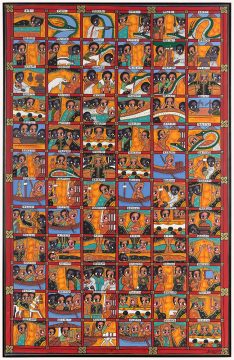
Ethiopia
Story of the Queen of Sheba
Mid-20th century
Paint on canvas
Gift of Joseph and Patricia Brumit, 2004-7-61
Hero in History: Queen of Sheba
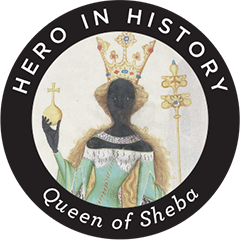
- While recorded in many of the sacred texts of the region, basic facts about the life of this remarkable woman remain unresolved.
- Accounts describing the “Queen of the South,” or the Queen of Sheba, may refer to Bilqīs, a queen of the Sabaean kingdom in modern Yemen. In Ethiopia, she is associated with Makeda, ruler of D’mt, a kingdom in Eritrea and northern Ethiopia.
- Trading regularly with Israel, the Queen learned of King Solomon’s fabled knowledge, and traveled to Jerusalem to see him for herself.
- While in Israel, she had a son by King Solomon, Menelik, who would return to Jerusalem as a young adult, to meet his father.
- Upon his homecoming to Ethiopia, Menelik is credited not only with founding the Solomonic dynasty (through which descent was traced until Emperor Hallie Selassie’s abdication in 1974) but also with bringing the Ark of the Covenant with him to Ethiopia.
